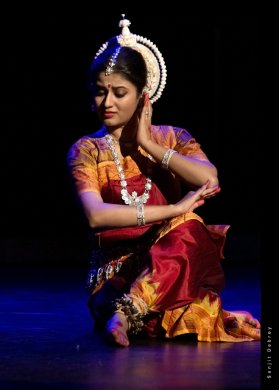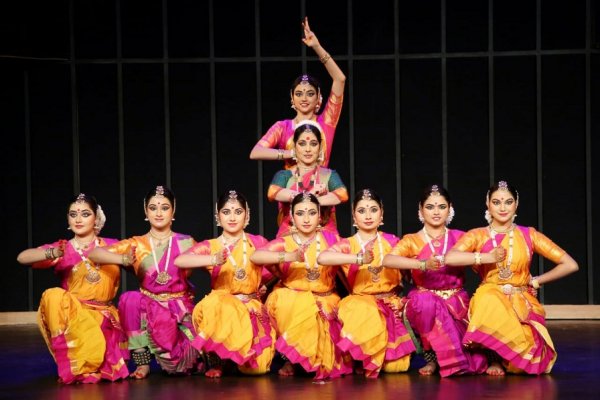
|   |

|   |
|
Shishya's turn to shine - Madhur Gupta e-mail: madhurgupta04@gmail.com August 16, 2019 A good teacher can inspire hope, ignite the imagination, instill a love for learning, and coax the student to pursue excellence. The transmission of oral traditions through generations of Guru-Shishya parampara, especially in the classical music and dance world quite evokes this sense of inspiration which the Guru provides their students with and let them shine. Subtle abhinaya Odissi dancer Monalisa Ghosh from Kolkata along with her troupe presented 'Bhaja Govindam' in the monthly dance series curated by India Habitat Centre, Delhi. One witnessed the age old classic solo compositions of Guru Kelucharan Mohapatra modulated by the artiste to suit the group format. The evening commenced with Sritakamala, an invocatory verse choreographed originally by her Guru from the Geeta Govinda, a 12th-century Vaishnavite literature composed by poet Jayadeva. Restructured in its format, the choreography of Monalisa Ghosh evoked a sense of nostalgia and set the mood for the evening. Belying her age, the veteran dancer then presented Kirwani Pallavi, again a gem of her guru with accompaniment to live music. The technical piece explores the rhythmic patterns in this sampoorna raga and although pure nritta, the raga has melancholic, heart-rending and sentimental feels to it which was portrayed by the seasoned artiste.  Arunima Ghosh (Photo: Sanjit Debroy) Strings of Harmony Contemplating on the exemplary qualities of Mahatma Gandhi, to commemorate his 150th birth anniversary, The Raza Foundation in collaboration with India International Centre organized a talk and chamber concert titled Singing Gandhi: Kumar Gandharva's 'Gandhi Malhar' featuring his daughter and disciple Kalapini Komkali and a staunch Gandhian S N Subbarao. Subbarao, a close associate of Kumar Gandharva, commenced the talk by introducing Gandhi as a maharaga which resounded even in the remotest corners of the nation and stringed harmony in all the beings. "Of course we all know how the legend popularized bhajans Vaishnav jan to or Raghupati Raghava Raja Ram as a medium of spreading concord. Gandhi was closely connected to music and musicians; he persuaded MS Subbulakshmi to sing Hari tum haro just a few months after 1947 partition," ruminated the social worker on how extensive was Gandhi's personality that it did not even leave the field of music untouched. In the late 1960s Shivaputra Siddharamayya Komkali, better known as Kumar Gandharva, was requested by the Gandhi Centenary Samiti to create a raga inspired by Gandhiji's philosophy and ideals. "My father used to often say, 'Can there be a better model for selflessness, compassion, simplicity and non-violence? My song is conceived not as a tribute to the man but to his values," recollected Kalapini Komkali. Explaining the intricacies of the raga before rendering it, Komkali stated, "Since my father constructed the raga according to Gandhiji's persona he thought it should have the dual opposing elements of Karuna with Abhaya. Thus Malhar raga was chosen as a base as it has a gambhirta (seriousness) to it with a lot of flexibility. With the sturdy unassailable Shuddh Gandhar, it also has the softness of Komal Nishadh."  SN Subbarao  Kalapini Komkali Eternal Cycle One explored the myriad ephemeral cycles of nature at India Habitat Centre with 'Akhandalaya: The Unvanquished', a thematic dance production envisaged and brought to life by Guru Jayalakshmi Eshwar in Bharatanatyam format, that explored the infinite, unalterable and untamable rhythms of the cosmos. From the cyclic movement of planets around the Sun, and their satellites around them contained within the solar system, to human-made creative inventions of rhythm demonstrated in artistic mediums, the production celebrated all rhythmic patterns that govern life and its various aspects. The production began with 'Eternal Rhythm', an exploration of cosmic rhythms and energies, such as the Sun, the rotation and the revolution of the Earth, the Moon, the seasonal cycles and so forth. 'Antar jyoti para jyoti pratya jyoti paraparan, Jyotir jyoti swayam jyoti aatmar jyoti Shivosmaham' (I am the light on the inside, on the outside, I am the light itself, I am Shiva), was the verse used to pay homage to Shiva, the true energy behind the cosmic manoeuvres. Describing the moon's advent through the episode of Samudra Manthan, the piece also paid obeisance to Surya, Earth, and the Navagrahas.  Akhandalaya The next segment was dedicated to metaphysical cycles and rhythms that operate through the cyclical seasons. Bengali, Hindi and Tamil adopted from Sangam Literature, were utilised to describe their characteristics. 'Configurations of Rhythm', the succeeding piece explored the human creativity of composing and creating rhythmic patterns of their own. Using the five jatis, Jayalakshmi Eshwar brought out the intricacies of human creativity. Traversing through scientific concepts of water and food cycle, and juxtaposing them, the final segment 'Akhandalaya' questioned what would happen if these rhythmic cycles were to come to stop. The artist urged the audience to witness the infiniteness of nature, and acknowledge the fact that if it had not been for these rhythms, life would not have been possible. The entire troupe spoke of the precise training rendered by Eshwar. Anannya Chatterjee, one of the prime disciples and repertory member stood out from the rest with her agile and clean movements and deft technique and one must congratulate the Guru for training her students to a caliber of being a soloist and also stringing such eternal concepts through exploring the uncharted seas of scientific treatment of these mythological subjects. Odissi dancer Madhur Gupta is a disciple of Guru Sharon Lowen. He contributes to national dailies like The Hindu, The Times of India, The Asian Age, The Indian Express covering at large the Indian classical dance and music scene of the subcontinent. |